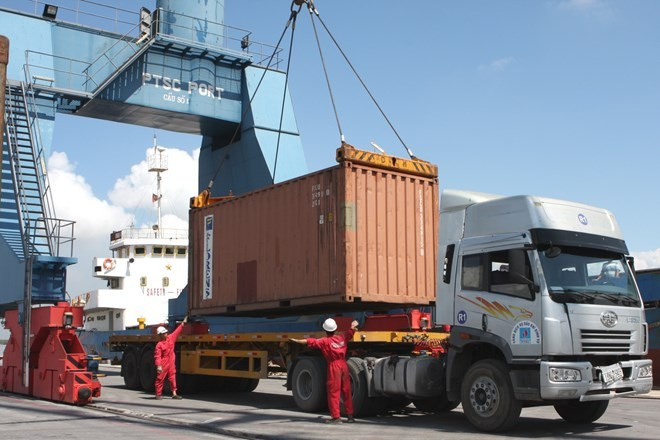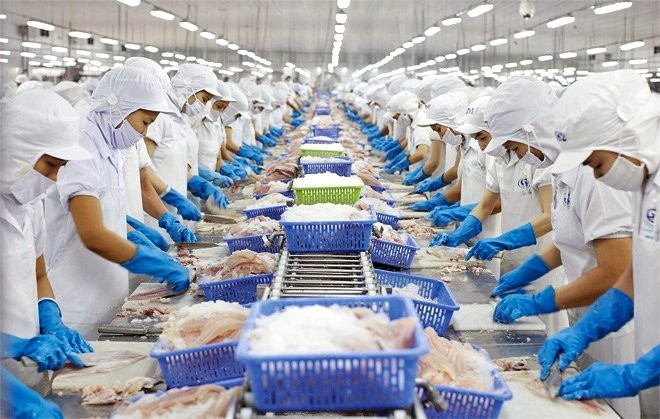
UOB raises Vietnam's GDP forecast for 2025 to 7.7% thanks to impressive growth. (Photo: Vietnam+)
On November 10, the Global Economic and Market Research Department of UOB Bank (Singapore) announced the Vietnam Economic Outlook report for the fourth quarter of 2025, stating that Vietnam's economic growth results in 2025 so far have exceeded expectations, despite risks from US tax policies.
Strong growth in the third quarter
Vietnam’s real GDP grew by a strong 8.23% year-on-year in the third quarter, boosted by strong exports and manufacturing despite US tariffs, according to a UOB report. This is the highest quarterly growth since the third quarter of 2022, when the economy recovered from the COVID-19 pandemic with an increase of 14.4%.
The 3Q2025 results followed the 8.19% growth in the 2Q (upgraded from the initial estimate of 7.96%), far exceeding Bloomberg's forecast of 7.2% and UOB's forecast of 7.6%. Overall, the Vietnamese economy grew 7.85% year-on-year in the first nine months of 2025.
UOB experts said that this impressive performance mainly comes from vibrant international trade activities and strong production output. In the period of January-September 2025, export turnover increased by 16% compared to the same period, of which exports to the US increased by 27.7%, despite the imposition of tariffs. Industrial production also recorded a steady increase, reaching 10.8% in 9 months, higher than the increase of 9.4% in the same period in 2024.
The manufacturing PMI rebounded in September, marking the third consecutive month above 50, reversing the downward trend of the previous three months. This suggests a stabilizing manufacturing outlook, further bolstered by accelerated disbursement of foreign direct investment (FDI), which reached $18.8 billion in the first nine months, up 8.5% year-on-year. If this momentum continues in the fourth quarter of 2025, total FDI for the year could approach the record $25.4 billion set in 2024.
Outlook - Will the impact from US tariffs come late?
On the tariff front, UOB experts said that on a positive note, the US President announced on July 2 a 20% tariff on imports from Vietnam to the US, along with a 40% tariff on goods in transit. While significant, this is still much lower than the 46% tariff initially announced on April 2, known as “reciprocal tariffs.” The tariff uncertainty has eased somewhat in the second half of 2025 after the US finalized its country-specific tariff rates before the August 1 deadline. The tariff rate for Vietnam is set at 20%.
While lower than the initial threat of 46%, concerns remain, the UOB expert added. The 40% tariff on transshipment goods currently lacks specific guidance and there is no clarity on how “transshipment” is defined. Some sectoral tariffs have been announced, notably for the furniture industry, but again without specific details. However, the furniture group (HS 94) accounts for about 10% of total US imports from Vietnam in 2024 and will be an area of concern as the tariff impact becomes more apparent.
It should be stressed that Vietnam is particularly vulnerable to trade tensions such as US tariffs, due to the open nature of its economy: exports of goods and services account for 83% of GDP - the second highest in ASEAN after Singapore (182%) - and its high dependence on the US market.
The US is Vietnam's largest export market in 2024, accounting for 30% of total export turnover of 406 billion USD, followed by China (15%) and South Korea (6%).
Key export items to the US include electrical products HS85 (41.7 billion USD), telephones and related equipment HS84 (28.8 billion USD), furniture HS94 (13.2 billion USD), footwear HS64 (8.8 billion USD), knitted garments HS61 (8.2 billion USD) and non-knitted garments HS62 (6.6 billion USD). These product groups account for nearly 80% of Vietnam's total exports to the US in 2024.

The US is Vietnam's largest export market in 2024. (Photo: Vietnam+)
While Vietnam’s trade performance has so far shown stability despite the US tariffs, a potential scenario is that export orders could start to decline as US businesses complete their pre-orders to avoid tariffs (a phenomenon known as pre-ordering) and rising prices begin to impact the purchasing power of US consumers, particularly in 2026.
“With a growth rate of 7.85% in the first three quarters of the year, Vietnam’s economic outlook for 2025 remains positive. However, given the high baseline in 4Q24, the final quarter is expected to be challenging amid tariffs and trade tensions. Therefore, we maintain our 4Q25 growth forecast at 7.2%, while revising up our full-year growth forecast to 7.7% from 7.5%. However, to achieve the official growth target of 8.3%-8.5%, 4Q25 will need to achieve very high growth rates of 9.7%-10.5%,” the UOB expert emphasized.
The State Bank of Vietnam keeps interest rates unchanged for the time being.
With strong economic growth in the past 9 months and no signs of slowing down, UOB experts believe that the State Bank currently has very little room to loosen monetary policy. Meanwhile, inflationary pressures remain, with September inflation reaching 3.38% year-on-year, up slightly from August's 3.24%. Year-to-date, inflation averaged 3.3% (overall) and 3.2% (core inflation), with core inflation exceeding the levels of 2024 (2.9%) and 2023 (3%).
The foreign exchange market is also an important factor in the SBV's policy considerations. The Vietnamese Dong (VND) was the second-worst-performing currency in Asia in the first nine months of 2025, falling 3.55% against the USD, just below the 3.58% decline of the Indian rupee and slightly higher than the 3.38% decline of the Indonesian rupiah. In contrast, currencies in the region benefited from the weakening trend of the USD, with gains ranging from 7.65% for the TWD (Taiwanese Taiwan) to 2.5% for the CNH (Chinese Yuan outside mainland China).
The VND is still hovering near its record low of 26,436 VND/USD hit in August, as the State Bank of Vietnam continues to adjust its reference exchange rate in a way that devalues the local currency. Although the correlation between the USD/VND exchange rate and the DXY index (USD strength) is quite limited, the VND may react more slowly than regional currencies to the weakening trend of the USD, especially when the US Federal Reserve (Fed) carries out further interest rate cuts.
Against this backdrop, UOB maintains a cautious view on the outlook for VND and revises its USD/VND forecasts as follows: VND26,400 in Q4/2025, VND26,300 in Q1/2026, VND26,200 in Q2/2026 and VND26,100 in Q3/2026.

Mr. Suan Teck Kin - Head of Global Market and Economic Research, UOB Bank. (Photo: Vietnam+)
Mr. Suan Teck Kin - Head of Global Markets and Economics Research, UOB Bank shared that the outlook for the end of 2025 remains positive thanks to strong performance in the first three quarters of the year, especially in the export sector. Currently, Vietnam is one of the fastest growing economies in ASEAN with a forecast of more than 7%, surpassing Indonesia (5%), Malaysia (4.6% - 5.3%), Singapore (3.52%) and Thailand (2% - 3%). The manufacturing industry is a differentiator and a key driver, bringing higher added value compared to resource-based industries such as agriculture or mining, thereby consolidating Vietnam's strong position in the region.
“In the long term, Vietnam aims to increase GDP per capita from over 4,000 USD at present to 8,500 USD by 2030. With an average growth rate of about 7% per year, this target is completely feasible. However, the development of synchronous and strong infrastructure is the key factor to effectively take advantage of opportunities and promptly respond to emerging challenges,” Mr. Suan Teck Kin added./.
(Vietnam+)
Source: https://www.vietnamplus.vn/uob-nang-du-bao-gdp-viet-nam-nam-2025-len-77-nho-tang-truong-an-tuong-post1076065.vnp




![[Photo] Prime Minister Pham Minh Chinh attends the annual Vietnam Business Forum](https://vphoto.vietnam.vn/thumb/1200x675/vietnam/resource/IMAGE/2025/11/10/1762780307172_dsc-1710-jpg.webp)

![[Photo] Prime Minister Pham Minh Chinh attends the Patriotic Emulation Congress of the Ministry of Foreign Affairs for the 2025-2030 period](https://vphoto.vietnam.vn/thumb/1200x675/vietnam/resource/IMAGE/2025/11/10/1762762603245_dsc-1428-jpg.webp)




















































































![Dong Nai OCOP transition: [Article 3] Linking tourism with OCOP product consumption](https://vphoto.vietnam.vn/thumb/402x226/vietnam/resource/IMAGE/2025/11/10/1762739199309_1324-2740-7_n-162543_981.jpeg)











Comment (0)